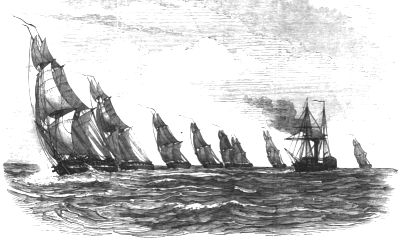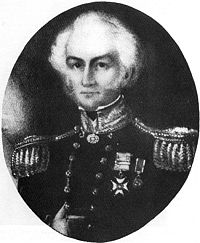 12 gun sloop Daring
12 gun sloop Daring
|
Captain Sir William Peel V.C. K.C.B
|
| [ Home ] | [ Peel home ] |
| Page... < prev. | 1 | 2 | 3 | 4 | 5 | next > |
continued from page 1 ...
After some time in the royal yacht William and Mary, Peel joined Cambrian 36, under Captain Henry Chads and served in the China War of 1840-42. This was the first of what were to become the opium wars. His ship however did not qualify for the medal issued for that action. He came home in October 1843 and in November he went to the gunnery school at HMS Excellent, where he passed all his examinations in such a short time, five months when the normal was at least fourteen months. He passed with such brilliance that Sir Robert Hastings, captain of Excellent, and Sir Charles Napier both publicly upon his success. He received his commission as Lieutenant on 13th May 1844, only a week after he passed his last examination, and his father, who was then Prime Minister, felt obliged to assure the House that he had used no influence at all on his son's behalf.
 12 gun sloop Daring
12 gun sloop Daring
|
At that period junior officers often signed themselves on to the books of several ships so as not to lose time and seniority, and Peel is recorded as being in several ships in 1844 when he was in fact in London enjoying some social life and studying gunnery at Woolwich. He was however in the Government steam yacht Black Eagle that brought Czar Nicholas on a state visit. Finally he was appointed to Thalia 42 on the Pacific Station and went out in the flagship Collingwood as a supernumerary. When the America 50 was sent North to investigate unrest between American and Canadian settlers in the Oregon Territory, Peel went with her and, with a marine officer and officials of the Hudson Bay Company carried out the survey to try and determine the dispute. Peel was sent home early via Mexico to report on the situation.
After two temporary appointments, on the steam sloop Devastation and the Constance 50, Peel was promoted Commander on 27th June 1846, at the age of 21. He was given command of the 12 gun sloop Daring.
She was serving on the North American and West Indian Station under Admiral Sir Francis Austen. Sir Francis Austen was of course one of the two Admiral brothers of the famous author Jane Austen.
 Admiral of the Fleet.
Admiral of the Fleet.Sir Francis Austen. |
If you have ever wondered what the number at the end of a ship's name was, it is to indicate how many guns it had and therefore its size. As ship's, in the time Peel was doing his naval career, were divided into six rates.
All of these ships were commanded by post-captains, any vessel that carried less than 20 guns were not rated. Any ship that carried in excess of 60 guns was called a ship of the line, because it was they alone that could stand in the line of battle when two fleets came into action. This is where the term Battleship comes from.
The first and second rates were three-deckers, that is to say that they had three whole decks of guns, apart from those on the quarterdeck and forecastle. The third and fourth rates were two-deckers and the rest one-deckers.
The main armament was a 32 pounder cannon this is determined from the weight of the cannon ball fired. This could smash through two feet of solid oak at a half mile. The cannon weighed two and three-quarter tons so it needed a gun crew of 10 men to operate it. If you have ever heard the expression two, six, ho! This refers to numbers two and six in the gun crew whose job it was, when it was loaded, was to run the gun out ready for firing.
The cannon had a range of three miles and this was used to determine the three-mile limit around coastlines. Coastal batteries had the same guns as well so the ships prudently observed the limit.
As a further point of interest we had 73, 74's, at the start of the wars against Napoleon and in 1816 we had 137, it is just as well we captured a good many off the French, Spanish and Dutch Navies because the weight of a 74 was about 1,700 tons or the equivalent of 2,000 oak trees or 57 acres of forest. No wonder the forests of England were decimated.
In February 1848, after British residents in Nicaragua had been molested and their property damaged, Peel took part in a punitive expedition up the San Jaun River. Daring paid off in October 1848 and Peel was promoted Captain on 10th January 1885. At 25 he was the youngest Post-Captain in the Navy, but because of the political situation, his father was no longer in power, he was told he could expect some years on half pay.
In January 1850, Peel applied unsuccessfully to be included in the expedition to search for Sir John Franklin. He then thought of going to Africa, with the object of examining and bettering the conditions of the Negroes. With this object in mind he studied Arabic for some months under his Arabic teacher Joseph Chuni, a Maronite, educated at Rome. And in September 1850, he proposed to Chuni that they would make a short tour together and visit Egypt, Mount Sinai, Jerusalem, Nazareth and Syria. Chuni agreed and the left England on 20th October and were back by February 1851. On 20th August 1851, they started on their African explorations, and went up the Nile and across the desert to Khartoum and on to El Obeid, where both travellers had a severe attack of fever and ague, and they returned prematurely. Peel published an account of his experience, "A Ride in the Nubian Desert" in June 1852. His father had died in July 1850 of course and left him £25,000 with which he brought a somewhat neglected estate at Sandy in Bedfordshire, where he brought land under cultivation, laid out gardens and walks, and repaired and enlarged the existing house.
In October 1852, Peel commissioned the Diamond frigate, attached to the fleet in the Mediterranean and afterwards the Black Sea. Field Marshall Sir Evelyn Wood then a midshipman on Queen commented years later that all of the Officers were anxious to see one who already had a service reputation as not only our youngest Post-Captain, but as one of the best William Peel was then thirty years of age.
continued on page 3 ...
| < prev | next > |